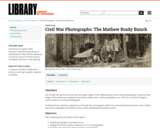
Students use Library of Congress primary sources to examine Civil War photographs as primary sources.
- Subject:
- History
- U.S. History
- Material Type:
- Lesson
- Lesson Plan
- Provider:
- Library of Congress
- Provider Set:
- Lesson Plans
- Date Added:
- 08/15/2022

Students use Library of Congress primary sources to examine Civil War photographs as primary sources.
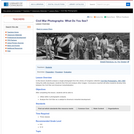
Students use Library of Congress primary sources to examine the Civil War and American industrialization.
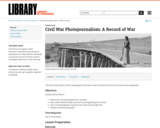
Students use Library of Congress primary sources to explore how and why war has been photographed and also see the bias within the recording/reporting of war.

This collection documents the Civil War experience of Captain Tilton C. Reynolds, a member of the 105th Regiment of Pennsylvania Volunteers. Comprising 164 library items, or 359 digital images, this online presentation includes correspondence, photographs, and other materials dating between 1861 and 1865. The letters feature details of the regiment's movements, accounts of military engagements, and descriptions of the daily life of soldiers and their views of the war. Forty-six of the letters are also made available in transcription.
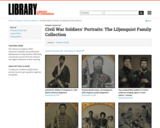
A selection of Library of Congress primary sources exploring the Civil War portraits in the Liljenquist Family Collection of Civil War Photographs from the Library of Congress. This set also includes a Teacher s Guide with historical context and teaching suggestions.
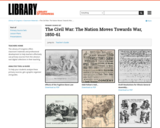
Conflict between abolition and slavery marked the 1850s, preceding the election of 1860 and the attack on Fort Sumter that started the Civil War. The Kansas-Nebraska Act, Dred Scott, Harriet Beecher Stowe, John Brown, and secession in maps, newspapers, political cartoons and song sheets.
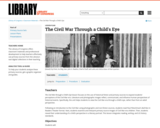
Students use Library of Congress primary sources to examine the Civil War from a child's perspective.
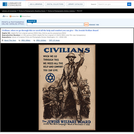
Poster showing a soldier reaching out above the chaos of battle. United War Work Campaign - Week of November 11, 1918. Title from item. Gift; John Kluge; 2007; (DLC/PP-2007:024).
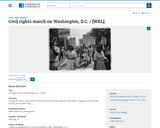
Photograph shows a procession of African Americans carrying signs for equal rights, integrated schools, decent housing, and an end to bias. Students will list their observations, make inferences, and devise questions while working in small cooperative learning groups using the LOC Primary Source Analysis Tool. Special attention should be drawn to the vocabulary (integrated, bias, and equal rights) words on the signs. Were African Americans truly free? What bound them? How does "separate but equal" play here? Does equal mean the same thing for everyone? How did perspectives impact society at this time?
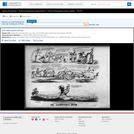
Four vignette cartoon shows Brother Jonathan kicking the confederacy, Napoleon III, and Emperor Maximillian, represented by animals, with his "iron-clad" boots. In the next vignette, Brother Jonathan fills the feed dish of the American eagle with yellow pills, from which the bird produces specie, "green backs." In the third vignette, men ride horses which have the heads of Abraham Lincoln, John Charles Fremont, Pomeroy and Gilbert. The journalist, Horace Greeley, is thrown from his mount. They head toward Richmond. In the fourth vignette, titled, "The Yankee rooster converting English blockade runners into iron-clads and monitors," the rooster consumes English blockade runners and turns them into iron-clads and monitors through the process of elimination.|Lithograph by G.W. Lascell.|Title appears as it is written on the item.|Forms part of: American cartoon print filing series (Library of Congress)
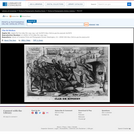
Another Whig campaign satire, picturing incumbent Martin Van Buren and his Democratic advisers or "Kitchen Cabinet" routed by Whig candidate William Henry Harrison. In a domestic kitchen Harrison, dressed as a scullery maid, raises a "buttermilk dasher" against a party of fleeing Democrats. The fugitives are (left to right, standing): Secretary of War Joel Poinsett, Postmaster General Amos Kendall, Washington "Globe" editor Francis Preston Blair (arms outstretched, looking left), Secretary of State John Forsyth, John Calhoun, Levi Woodbury, and Van Buren. Thomas Hart Benton (left) and Alabama Representative Dixon H. Lewis, a States Rights Democrat, have fallen to the floor. Harrison: "Gentlemen as you don't like hard Cider I will give you a taste of the Buttermilk Dasher." Van Buren: "This is worse than the Rebellion in Vermount!" Poinsett: "If you had followed my advice we would have had by this time our Standing Army of 200,000 men." Blair: "I shall leave the Globe!" Forsyth: "I shall never be Vice President." Calhoun: "I am for the South direct." Woodbury: "I can issue no more Treasury Notes!" On the far left a bespectacled man with plaited hair (Pennsylvania Democratic congressman David Petrikin) holds up his hand and says, "I object." The man lamenting his lost hopes for the vice presidency has been previously identified as Alabama Senator William Smith. Yet comparison of the likeness here with Charles Fenderich's 1840 lithographed portrait of Secretary of State John Forsyth confirms identification of the man as that cabinet member. The print is most probably by Napoleon Sarony, showing the same distinctive, patterned cross-hatching and broad crayon-work as his "The New Era or the Effects of a Standing Army "(no. 1840-3). "Clar de Kitchen" was the title of a popular dance song of Negro minstrel comic T.D. Rice.|Entered . . . 1840 by H.R. Robinson.|Printed & published by H.R. Robinson, 52 Cortlandt St. N.Y. & Pennsa Avenue Washington D.C.|Signed: Boneyshanks (probably Napoleon Sarony).|Title appears as it is written on the item.|Blaisdell & Selz, no. 17.|Century, p. 54-55.|Weitenkampf, p. 64.|Forms part of: American cartoon print filing series (Library of Congress)|Published in: American political prints, 1766-1876 / Bernard F. Reilly. Boston : G.K. Hall, 1991, entry 1840-44.
![[Clay-Frelinghuysen Campaign Badge]](https://img.oercommons.org/160x134/oercommons/media/upload/materials/screenshots/materials-course-76039.png)
An earlier state or proof of number 1844-6, this impression is printed on silk and lacks the "Hoboken Clay Club" overprinting. (The scrolls are left blank.)|Entered . . . 1844 . . . Southern District of New-York, by R. Hemming, 31 Maiden Lane, N. Y.|This proof was deposited for copyright on June 3, 1844.|Title appears as it is written on the item.|Published in: American political prints, 1766-1876 / Bernard F. Reilly. Boston : G.K. Hall, 1991, entry 1844-7.
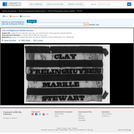
Print shows a Whig campaign banner composed of a pattern of alternating red and white stripes reminiscent of the American flag. On each of the four white stripes appears the name of a Whig candidate for the 1844 election. These include Henry Clay, vice-presidential hopeful Theodore Frelinghuysen, and the names "Markle," and "Stewart."|Title appears as it is written on the item.|Published in: American political prints, 1766-1876 / Bernard F. Reilly. Boston : G.K. Hall, 1991, entry 1844-10.
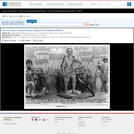
The artist lionizes Kentucky senator Henry Clay, author of the Compromise of 1850, and slams his political foes and critics of the compromise, particularly those in the Taylor administration. A text in the lower margin reads: "A Fable--In the Reign of Zackery 1st the Goddess of Liberty Designed a Statue. a Model of a Man which she exhibited before the King, his Ministers, & the People. the Beauty of the Statue Elicited such shouts of Approbation from the People that the King's Ministers fired with Jealousy determined to Destroy it, but after many Ineffectual attempts were obliged to Desist amidst the Laughter of the Court & the People." The King is clearly President Taylor, who sits on a throne at the far left, in uniform and holding a sword instead of a scepter. A spittoon is on the floor before him, and a black court jester crouches beside the throne holding a copy of the newspaper the "Republic." A larger-than-life statue of Henry Clay, in armor and holding a shield inscribed "Compromise" and a sword, stands in the center of the scene. Clay's sword bears the words, "I fight for my Country! Traitors Beware." The statue towers over the figures that surround it, which include Taylor cabinet members Reverdy Johnson, George W. Crawford, and Thomas Ewing (on the right) and Secretary of State John M. Clayton (on the left). Crawford and Ewing regard the broken ax and saw which they hold in their hands. Crawford (to Johnson): "Look here Just see what a great Big Piece Ive Broke of my Gulpin Ax. I'll send in a Gulpin Claim for this. Valuable Ax this." The allusion is to Crawford's lucrative and questionable role as counsel for the Galphin family's successful suit against the federal government, an arrangement which provoked heated criticism in the press. The controversy over this Taylor administration scandal reached its peak in April, May and June of 1850. Johnson: "The Ax, was Broke before you used it, however, you Lie & I'll Swear to it, & we'll Pockett the Plunder between us." Ewing: "Why Ive Broke nearly all the teeth of my Chickensaw against this Infernall Statue. I'le send in a Big Claim for this." Clayton gestures entreatingly to Taylor: "Why the Devil dont your Imperial Majesty assist us, I can assure your Majesty, it's much Easier discharging a Bullitt, from a Republic, than it is injuring this Statue." Journalist Alexander C. Bullitt was a Taylor advisor and, beginning in 1849, editor of the administration organ the Washington "Republic." Bullitt appears here as the black court fool. Taylor hugs to his chest the tiny figure of New York senator William H. Seward, who sits on his lap. Seward was an insider in the short-lived Taylor administration, and a vigorous opponent of the Compromise of 1850. Taylor says, "Consider the weight of my Crown, Dear Clayton. besides my sick Baby, little Billey, requires, all my Care. moreove as the People like the Statue, I'de rather not Compromise myself, in the matter. assume the Responsibility Yourself, you'r used to it." Just to the right of the throne stand (left to right) senators Thomas Hart Benton, Daniel Webster, and Henry S. Foote. Benton: "Why its a Miserable Statue. a wretched abortion, the inscriptions on the Sword & Shield are in very Bad Taste, very Bad Taste indeed." Benton was an adamant critic of the Compromise. Foote (to Webster): "I think its a Splendid Statue. Which Party do you go for." Webster: "The Party thats likely to win. Of Course, I shall Keep one eye on the Statue, & the other on the Chair, & act according to circumstances." Senator Lewis Cass stands to the right of Foote, in the background, saying, "I rather like the Inscription on the Shield." Clay does, however, have some friends here. On the far right is a crowd of people led by the figure of Liberty, a young maiden in a classical gown holding a staff and liberty cap. She addresses Johnson and the others, "Gentlemen! I made this Statue as a Model of a Man. now though it is only of Clay & I wafted it here in a Breath, still with all your efforts, you can neither move it from its Base, or inflict the slightest Injury upon it. its innate strenght [sic] will defy all your Puny attempts." Liberty's followers enjoin, "Why I think it's a Beautifull Statue," and "So do I! Hurrah! for the Clay Statue." "The Clay Statue," though tentatively dated 1849 by Weitenkampf, must have appeared in 1850, certainly after Henry Clay's presentation of the compromise in January and probably as late as the spring, at the height of the Galphin controversy.|Drawn by John L. Magee.|Pubd. by John L. Magee 34 Mott St. N.Y.|Title appears as it is written on the item.|Weitenkampf, p. 98.|Forms part of: American cartoon print filing series (Library of Congress)|Published in: American political prints, 1766-1876 / Bernard F. Reilly. Boston : G.K. Hall, 1991, entry 1850-9.
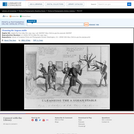
A pro-Whig satire, envisioning the cleansing of the "Augean Stable" of government corruption by presidential candidate Henry Clay and other Whigs. The title derives from one of the twelve mythical labors of Hercules. The hero was to clean King Augeas's stables, which had been inhabited for thirty years by three thousand oxen. The artist draws a parallel with the White House, held almost continuously since 1829 by the Democrats. The artist applauds Whig opposition to the annexation of Texas, illustrated by Virginia congressman Henry A. Wise's expulsion of "Madam Texas" at left. Wise says, "You will go about your business & lurk around these premises no longer. Your former master has forbidden all persons to harbor or trust you, & we shall not pay your debts for you." The "former master" was Mexico, who, though granting Texas its independence in 1836, still considered the Lone Star Republic a wayward province. With a pitchfork, Henry Clay tosses his Democratic counterpart James Polk out the window while incumbent President John Tyler throws George Dallas out the same window. Clay says, "It's all very well, Mr. Polk, but you can't come here." Andrew Jackson, poking his head in a nearby window exclaims, "By the eternal! We shan't know the old place, these fellows have gutted it so completely." To their left, Daniel Webster shovels out Thomas Hart Benton's gold coins, or "mint drops." Senator John C. Calhoun carries "fox" Van Buren toward the door, holding him unceremoniously upside-down by the tail. "Cleansing the Augean Stable" evidently appeared in the summer of 1844. (The Library's impression was deposited for copyright on July 10.) The appearance of Calhoun and Tyler, ostensibly on the side of the Whigs here, is puzzling. Calhoun and Tyler, both strong annexationists, had by this time lined up fairly decisively behind the Democratic candidates.|Drawn by H. Bucholzer.|Entered . . . 1844 by James Baillie.|Lithography & print coloring on reasonable terms by James Baillie No. 33 Spruce St. New York.|Title appears as it is written on the item.|Weitenkampf, p. 79.|Forms part of: American cartoon print filing series (Library of Congress)|Published in: American political prints, 1766-1876 / Bernard F. Reilly. Boston : G.K. Hall, 1991, entry 1844-35.
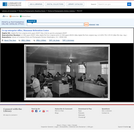
Men and women seated at desks with typewriters and other office equipment. Title transcribed from Ansel Adams' caption on verso of print. Original neg. no.: LC-A351-3-M-33. Gift; Ansel Adams; 1965-1968. Forms part of: Manzanar War Relocation Center photographs.
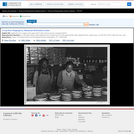
Two men and a woman standing behind store counter with display of pies. Title transcribed from Ansel Adams' caption on verso of print. Original neg. no.: LC-A35-6-M-41. Gift; Ansel Adams; 1965-1968. Forms part of: Manzanar War Relocation Center photographs.
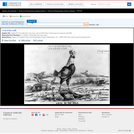
The title refers to Whig candidate Zachary Taylor as the probable victor in the 1848 presidential contest. Taylor is portrayed as a victorious fighting cock, standing over his dead opponent, another cock with the head of Democratic candidate Lewis Cass. Taylor crows, "Cru-e-ruk-ruk-ru have you any more of the kind on hand?" Feathers are strewn about in the foreground; a lake or river and large mountains appear in the distance. Nearby lies a second defeated cock, Free Soil party candidate Martin Van Buren. At the far right a fourth rooster, Liberty party candidate John Hale, flees, exclaiming, "I'm off in time!" Hale's flight may symbolize the candidate's exit from the campaign, which was prompted by Van Buren's nomination by a coalition of Liberty party abolitionists, Barnburner Democrats, and antislavery Whigs in August 1848.|Probably drawn by E.F. Durang.|Published by Able [i.e., Peter E. Abel] & Durang Philadelphia.|Title appears as it is written on the item.|Weitenkampf, p. 94.|Forms part of: American cartoon print filing series (Library of Congress)|Published in: American political prints, 1766-1876 / Bernard F. Reilly. Boston : G.K. Hall, 1991, entry 1848-45.
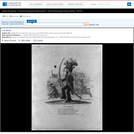
Caricature of John or Jonathan Pluck, an illiterate hostler elected Colonel of the 84th Pennsylvania militia in a controversial 1824 election. He is shown here marching toward the left, raising a sword inscribed "Ducit amor patria." According to Nancy Halli of the Historical Society of Pennsylvania, several articles appeared in the "Democratic Press" and "United States Gazette" following his outrageous militia parade in May 1825, and could have inspired the print. In the background is a crowd of militia troops armed with tree branches and brooms. One man holds aloft a flag emblazoned with a man milking a cow; another flag shows two men sawing a log. A black youth rides by on a pig, saying "Hurra for de Pennsylwamy light infamy." He is followed by a barefoot militiaman riding a cow. Below the title are the verses: "I could not stir, / But like a comet, I was wonder'd at; / Others would tell their children "This is he" /Others would say - Where? which is the "Colonel?" / And then I stole all courtesy from heaven, / And dress'd myself in such humility, /That I did PLUCK allegience from mens hearts. Shakspr. The lines come from Shakespeare's "Henry IV," part one.|Signed: D.C. Johnston del. (David Claypool Johnston).|Title appears as it is written on the item.|Johnson, "D. C. Johnston, the American Cruikshank," Antiques, (July 1972), p. 102.|Murrell, p. 106.|Purchase; Caroline and Erwin Swann Memorial Fund.|Forms part of: American cartoon print filing series (Library of Congress)|Published in: American political prints, 1766-1876 / Bernard F. Reilly. Boston : G.K. Hall, 1991, entry 1825-2.
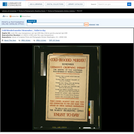
Title from item. Poster is text only, listing Germany's "crimes against God and man." Poster no. 97. W. 2464/446.